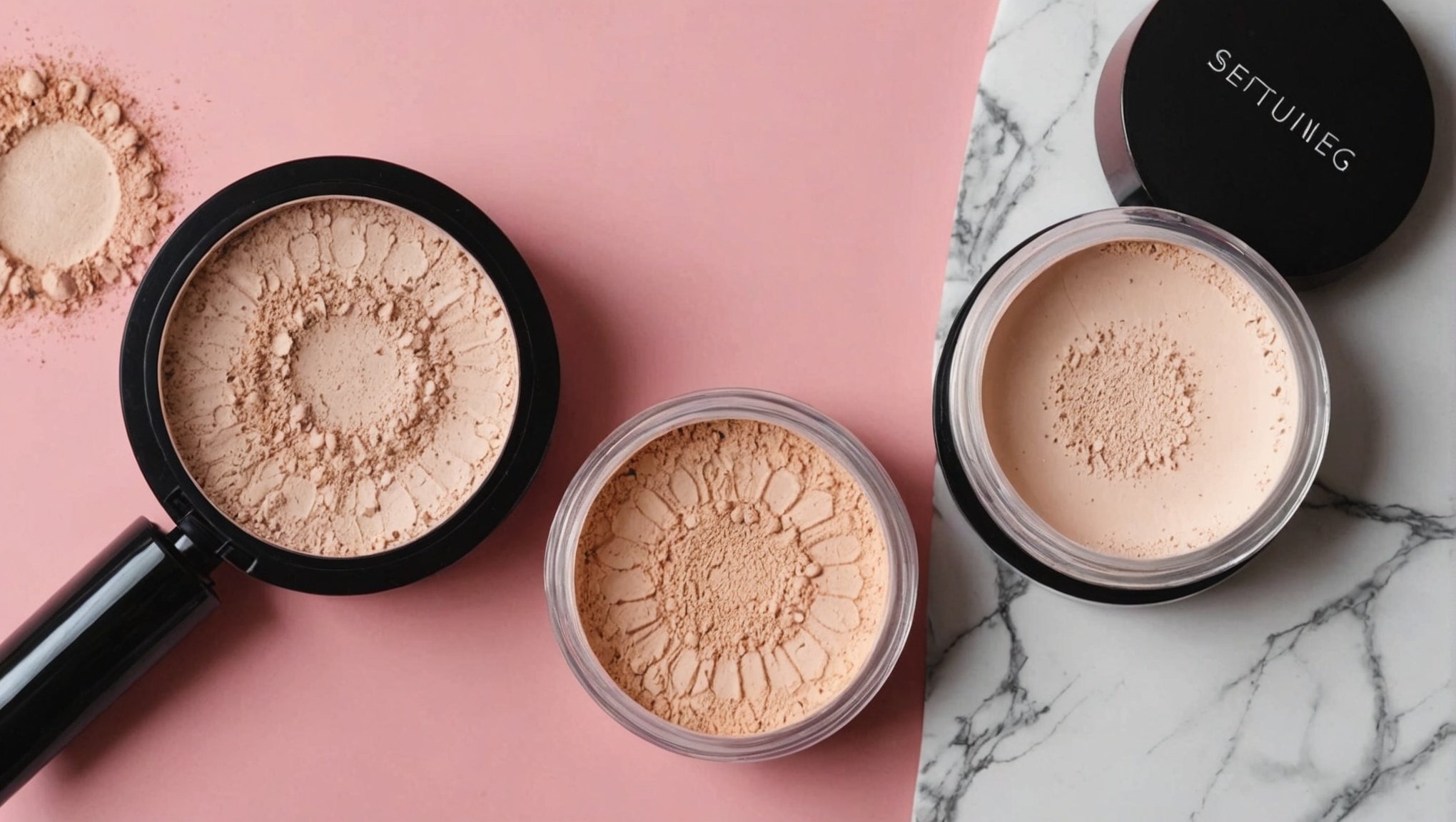Understanding Setting Powder and Setting Spray
When it comes to makeup endurance, both setting powder and setting spray are essential tools in any beauty routine. Understanding their definitions and purposes can help you determine which product best suits your needs.
Setting powder is primarily used to lock in makeup, providing a matte finish while absorbing excess oil. It is applied with a brush or puff after foundation and concealer, creating a smooth base that helps in preventing makeup from settling into fine lines. This is especially beneficial for those with oily skin, as it combats shine throughout the day.
Also to discover : Top short almond nail designs to inspire your next manicure
Conversely, setting spray offers a finishing touch that seals all layers of makeup with a light mist. It enhances makeup longevity by preventing fading and smudging throughout the day. While setting powder targets oily areas, setting spray works to maintain the overall integrity of your makeup, giving it a refreshing look.
A common misconception is that you must use either or both products. In reality, their effects can be cumulative, meaning using both can maximize the endurance of your makeup. With myths dispelled, it becomes easier to integrate these products into your routine wisely.
Also to read : Discover the Best Techniques for Gently Removing Waterproof Mascara Without Harsh Chemicals
Pros and Cons of Setting Powder
Exploring the benefits of setting powder reveals why it’s a beloved staple for many makeup enthusiasts. Primarily, setting powder is lauded for its ability to enhance makeup longevity by locking foundation and concealer in place. This is especially vital for those seeking an all-day flawless look, providing a matte finish that reduces shine and holds up against daily wear.
However, despite the benefits, there are noteworthy drawbacks of setting powder. For instance, individuals with dry skin types might find that certain powders exacerbate skin dryness or highlight fine lines and texture. Additionally, if not applied correctly, it can lead to a cakey appearance, diminishing the natural look that many prefer.
When it comes to application, employing the right methods can mitigate these downsides. Using a fluffy brush to lightly dust powder over the face ensures even distribution without overwhelming the skin. It’s also essential to tailor your choice of powder to your skin type – oily skin benefits from oil-absorbing formulas, while dry skin may require a hydrating option. This approach maximizes the positives while minimizing potential negatives, ensuring your makeup remains intact and flattering throughout the day.
Pros and Cons of Setting Spray
When it comes to makeup longevity, using a setting spray can be a game-changer. Benefits of setting spray include its ability to lock in your makeup, ensuring that it withstands the rigours of your day without needing constant touch-ups. Ideal for those long hours or special occasions, it provides a finishing touch that combats smudging and fading.
However, like any product, there are drawbacks of setting spray to consider. For oily skin, some sprays may contribute to a shinier complexion, while those with sensitive skin might experience irritation due to certain ingredients. It’s crucial to select a spray tailored to your skin type to maximise its effectiveness.
Best practices for applying setting spray involve holding the bottle at a distance from your face, typically about 8-10 inches, and misting in an “X” and “T” motion. This ensures an even application and comprehensive coverage, thus prolonging your makeup’s wear time.
By understanding both the benefits and potential downsides, users can make informed decisions about their makeup routine, tailoring it to their needs while enjoying the protective and enhancing qualities of setting spray.
Comparing Effects on Makeup Longevity
When evaluating makeup longevity, understanding how setting powder and setting spray affect wear time is crucial. While both products aim to extend makeup longevity, their effects vary based on skin type and individual preferences.
Setting powder is often recommended for those with oily skin, as it absorbs excess oil and reduces shine. It also works well in warmer climates, preventing makeup from melting away. Conversely, people with dry skin might find setting powder accentuates dry patches.
Setting spray, on the other hand, is versatile, suiting a broader range of skin types. It’s particularly beneficial for dry or combination skin, as it provides a hydrating finish without emphasizing dryness. Setting spray is ideal for those seeking a dewy look, ensuring makeup stays intact without needing additional mattification from powder.
Empirical studies suggest that setting sprays, infused with polymers, create a flexible barrier, enhancing makeup longevity across various conditions. Expert insights highlight the benefits of testing both products to determine which complements one’s skin type and desired finish. Ultimately, whether opting for setting powder or spray, makeup longevity is influenced by application techniques and environmental factors.
Expert Opinions and Recommendations
Understanding the various options available in makeup can be daunting, but learning from makeup artist tips can shed some light. Many artists prefer setting powders for oily skin types or when seeking a matte finish. On the other hand, setting sprays are often recommended for creating a dewy look, ideal for dry skin or achieving photoshoot-ready glam.
Makeup professionals often share product recommendations that cater to different styles. For example, they might suggest different foundations for a natural daytime look versus an evening makeup style. Specific brands may be highlighted for their staying power or for their natural ingredients, making them suitable for sensitive skin types.
User experiences contribute valuable insights, helping others discover what might work best for them. Reviews from individuals with similar skin concerns or lifestyle needs can offer practical advice.
Consulting these professional recommendations and user testimonials can guide one through the cosmetic maze, ensuring that each tool serves its purpose effectively. Whether aiming for daily wear or an intricate look, these insights ensure choices are tailored to needs and skin type, paving the way for a flawless finish.
Conclusion and User Guide
Navigating the world of makeup can seem daunting, but understanding the key differences between setting powder and setting spray is essential for achieving the desired finish. Each product has specific applications; knowing when to use each can make all the difference.
Key Differences and Applications
Setting powder is ideal for those with oily skin, aiming to mattify and control shine. It’s excellent for baking and setting foundation in targeted areas, providing a matte finish. On the other hand, setting spray is versatile for all skin types. It locks in makeup with a natural, dewy finish and is perfect for a full face application.
Decision-Making Guide
To choose the right product, consider your skin type and the makeup look you desire:
- For oily skin or a matte finish, opt for setting powder.
- For a dewy look or dry skin, setting spray is your ally.
Incorporating these tips can enhance your makeup routine. The Setting Products Guide can be a reference for exploring different options suited to your needs. With informed choices, your makeup will remain flawless throughout the day.
Visual tools, like charts or infographics, could further illuminate these distinctions, offering a straightforward approach to perfecting your makeup game.











